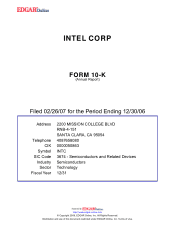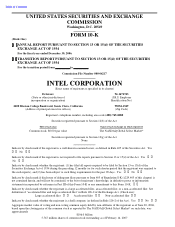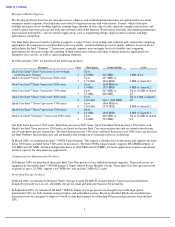Intel 2006 Annual Report Download - page 11
Download and view the complete annual report
Please find page 11 of the 2006 Intel annual report below. You can navigate through the pages in the report by either clicking on the pages listed below, or by using the keyword search tool below to find specific information within the annual report.
Table of Contents
Enterprise Market Segment
We develop platforms based on our microprocessors, chipsets, and motherboard products that are optimized for use in the
enterprise market segment, which includes entry-level to high-end servers and workstations. Servers, which often have
multiple microprocessors working together, manage large amounts of data, direct traffic, perform complex transactions, and
control central functions in local and wide area networks and on the Internet. Workstations typically offer higher performance
than standard desktop PCs, and are used for applications such as engineering design, digital content creation, and high-
performance computing.
Our Intel Xeon processor family of products supports a range of entry-level to high-end technical and commercial computing
applications. In comparison to our Intel Xeon processor family, our Intel Itanium processor family, which is based on IA-64
and includes the Intel
®
Itanium
®
2 processor, generally supports an even higher level of reliability and computing
performance for data processing, the handling of high transaction volumes and other compute-intensive applications for
enterprise-class servers, as well as supercomputing solutions.
In 2006 and early 2007, we introduced the following products:
Our Intel Xeon processor 5100 series, Intel Xeon processor 3000 series, Quad-Core Intel Xeon processor 5300 series, and
Quad-Core Intel Xeon processor 3200 series are based on the new Intel Core microarchitecture and are manufactured using
our 65-
nanometer process technology. The Intel Xeon processor 7100 series and Intel Xeon processor 5000 series are based on
the Intel NetBurst microarchitecture and are manufactured using our 65-nanometer process technology.
In March 2006, we launched the Intel
®
5000X Chipset family. This chipset is designed for workstations and supports the Intel
Xeon 5000 series and Intel Xeon 5100 series of processors. The Intel 5000X Chipset family supports FB-DIMM memory at
533 MHz and 667 MHz, and dual independent buses at 1066 MHz and 1333 MHz, for faster application response and greater
memory capacity for data-intensive applications.
Communications Infrastructure Products
In February 2006, we introduced three new Intel Core Duo processors for embedded market segments. These processors are
supported by the mobile Intel
®
945GM Express Chipset offered by the Mobility Group. These Intel Core Duo processors run
at speeds of up to 2.0 GHz, support a 667-MHz bus, and include 2 MB of L2 cache.
Networked Storage Products
In March 2006, we introduced the Intel
®
Entry Storage System SS4000-E, an Intel XScale
®
processor-based platform
designed to provide easy-to-use, affordable storage for small and mid-size business environments.
In September 2006, we introduced the Intel
®
IOP34x family of storage processors designed to provide high-speed
input/output (I/O) for both external storage products and embedded systems. Based on the Intel XScale microarchitecture,
these processors are designed to improve overall system performance by offloading I/O processing functions from the host
CPU.
5
Processor
Cores
Clock Speed
Front Side Bus
Cache
Dual-Core Intel
®
Xeon
®
processors Low Voltage
and Ultra Low Voltage
2
Up to
2.0 GHz
667 MHz
2 MB of L2
Dual-Core Intel
®
Xeon
®
processor 5000 series
2
Up to
3.73 GHz
667 MHz or
1066 MHz
4 MB of shared L2
Dual-Core Intel
®
Xeon
®
processor 5100 series
2
Up to
3.0 GHz
1066 MHz or
1333 MHz
4 MB of shared L2
Dual-Core Intel
®
Xeon
®
processor 7100 series
2
Up to
3.5 GHz
667 MHz or
800 MHz
Up to 16 MB of shared
L3
Dual-Core Intel
®
Xeon
®
processor 3000 series
2
Up to
2.66 GHz
Up to 1066 MHz
Up to 4 MB of shared
L3
Quad-Core Intel
®
Xeon
®
processor 5300 series
4
Up to
2.66 GHz
1066 MHz or
1333 MHz
8 MB of shared L2
Quad-Core Intel
®
Xeon
®
processor 3200 series
4
Up to
2.4 GHz
1066 MHz
8 MB of shared L2
Dual-Core Intel
®
Itanium
®
2 processor 9000 series
2
Up to
1.6 GHz
400 MHz or
533 MHz
Up to 24 MB of shared
L3
























